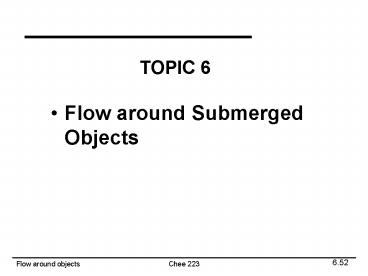Flow around Submerged Objects - PowerPoint PPT Presentation
1 / 9
Title:
Flow around Submerged Objects
Description:
Lift and Drag. A body immersed in a flowing fluid will experience pressure and viscous forces ... A man jumps out of an airplane at high altitude. ... – PowerPoint PPT presentation
Number of Views:1234
Avg rating:1.0/5.0
Title: Flow around Submerged Objects
1
TOPIC 6
- Flow around Submerged Objects
6.52
2
Framework
- Many practical situations involve flow past
objects. - Examples Flow of air around airplanes and
automobiles, flow of water around submarines,
design of road signs. - Applications in chemical engineering Flow in
packed beds, flow in fluidized beds, settling of
solids in gases or liquids, flow over cylinders,
flow through tube banks (important in heat
exchanger design).
6.53
3
Lift and Drag
- A body immersed in a flowing fluid will
experience pressure and viscous forces from the
flow. - The sum of forces (due to pressure and shear
stress) perpendicular to the direction of the
flow is called LIFT
- The sum of forces (due to pressure and shear
stress) acting in the direction of the flow is
called DRAG.
6.54
4
Determination of Drag Force
- Approaches
- Obtain detailed distribution of shear stresses
and pressure along the surface of the object - Use empirical approximations.
- It has been shown experimentally that the drag
force acting on a body
(6.24)
where A is the projected area of the body normal
to the flow and Cd the drag coefficient
6.55
5
Drag Coefficient
- The drag coefficient, Cd, depends on
- Shape
- Streamlined versus blunt bodies
- Smooth versus rough surfaces
- Particle Reynolds number
- The drag coefficient can be determined
analytically for certain simple geometrical
shapes at low Reynolds number flows, or
experimentally, by placing the object in a wind
or water tunnel and measuring the resistance as a
function of Reynolds number.
6.56
6
Drag Coefficient
- Values of drag coefficient for different shapes
as a function of Reynolds number can be found in
Figure 6.24 (6.22 2nd Ed.)of the textbook - For low Reynolds numbers (Relt1) Cd24/Rep (Stokes
law)
- In this case equation (6.24) becomes
(6.25)
Stokes flow
6.57
7
Settling Under Gravity
- An important class of problems involves settling
under gravity - An object falling in air or in any other fluid,
will attain a terminal velocity after an initial
period of acceleration. At terminal velocity the
sum of forces exerted on the object must be zero
Fweight-Fdrag-Fbuoyancy 0
6.58
8
Example 1 Settling under gravity
- A small grain of sand, diameter Dp0.10 mm and
specific gravity SG2.3, settles to the bottom
of a lake after having been stirred up by a
passing boat. Determine how fast it falls through
in still water.
6.59
9
Example 2 Settling under gravity
- A man jumps out of an airplane at high altitude.
Determine the velocity of fall (terminal
velocity) - without having opened his parachute, assuming a
drag coefficient of 1.1 and an area A0.5 m2. - with a parachute open having a diameter of 6 m,
assuming a drag coefficient of 1.2. - The mass of man and parachute is 90 kg and rair
0.909 kg/m3.
6.60
























![L-14 Fluids [3] PowerPoint PPT Presentation](https://s3.amazonaws.com/images.powershow.com/P1254413741tSZlY.th0.jpg?_=20150115090)






